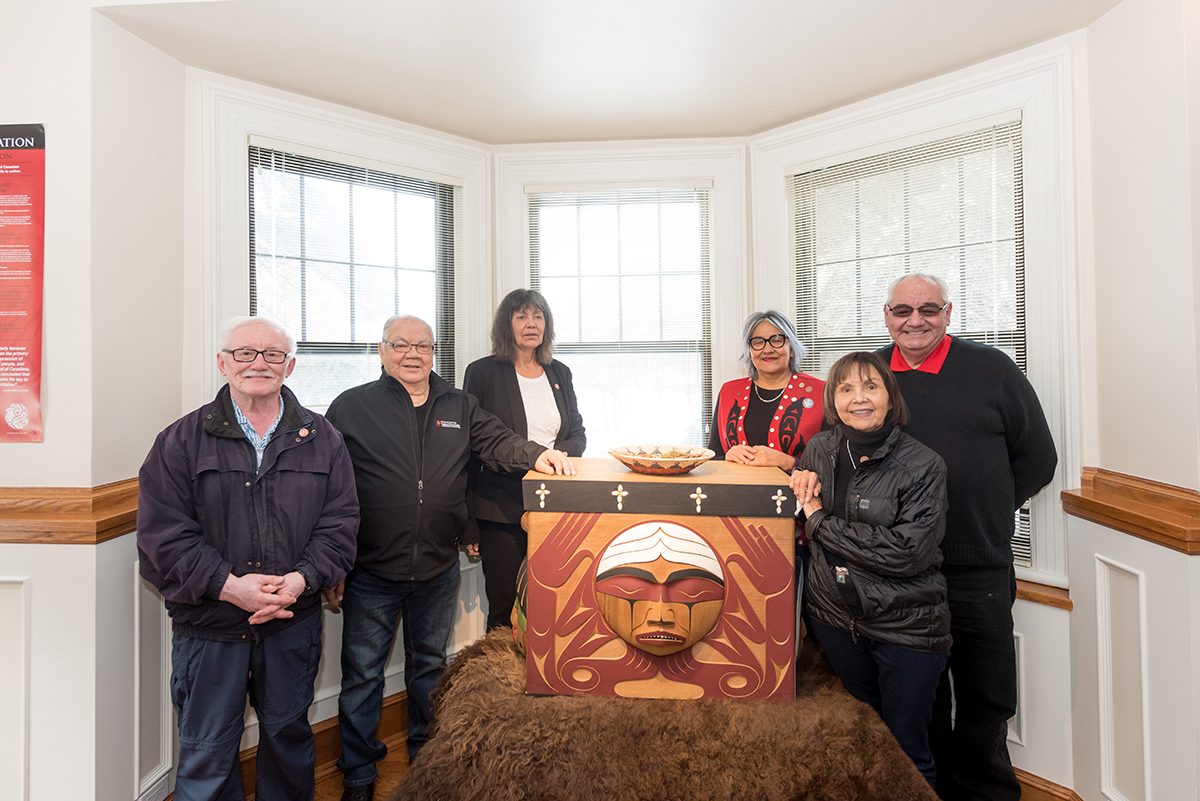
Survivors Circle members (l-r):Piita Irniq, Barney Williams, Helene Johnson, Terri Brown, Doris Young, Ted Quewezance (absent: Shirley Flowers)
Introducing the NCTR Survivors Circle
Last summer the National Centre for Truth and Reconciliation (NCTR) issued a call for Survivor representatives to sit on the Survivors Circle of the NCTR. The seven-member body was selected by the Governing Circle and officially welcomed in a ceremony on Jan. 25.
“Survivors created the process of Reconciliation that we now talk about in this country,” says Ry Moran, director of the NCTR. “It was Survivors who had the courage to speak out about the abuses they suffered in Residential Schools and that drove the creation of the Indian Residential School Settlement Agreement. It was the Survivors’ truth and the power of their statements that changed this country’s perception of itself. Having Survivors in the core of the NCTR is absolutely essential, not only for respecting the past but also understanding where we’re actually going.”
The Survivors Circle members are made up of First Nations, Inuit and Métis Survivors of the Residential School System from across the country.
The Survivors Circle members are:
- Terri Brown, Tahltan Nation, British Columbia
- Shirley Flowers, Rigolet, Labrador
- Piita Irniq, Lyon Inlet, Nunavut
- Helene Johnson, Archerwill, Saskatchewan
- Ted Quewezance, Keeseekoose First Nation, Saskatchewan
- Barney Williams, Tla-o-qui-aht First Nations, British Columbia
- Doris Young, Opaskwayak Cree Nation, Manitoba
“As a Survivor, for me, it’s very important that these records be preserved for future generations so we don’t forget what happened. Once it’s preserved in a proper way the records can last forever. That’s important to me.” says Terri Brown of the Tahltan Nation.
In 2003, as president of the Native Women’s Association of Canada, Brown broke the silence on the huge number of missing Indigenous women.
“For me it’s very important to bring the women’s voice to the circle because women have a central role in our communities and a central role in our families,” says Brown. “Also, it’s a connection to the people who didn’t survive. They never got to tell their story and that’s why it’s important to preserve it as much as we can. I’m doing it in the spirit of the children who didn’t come home and the ones who died without getting justice. There are so many. In my family we lost my brother and he never told his story. A lot of times I think of him when I’m doing this work.”
Eugene Arcand, another Residential School Survivor and member of the Governing Circle of NCTR states “There are still children walking the face of this world – in the spirit world – that have never had a chance to come home and they’re lost,” says Arcand. “We have to be careful how we move forward because they’re still there and that’s why we do what we do – for those who are lost, for those who have passed on and for those who never made it home, too.”
Other ceremonies took place on Jan. 25 as part of the welcoming of the Survivors Circle, including bringing the Bentwood Box of the TRC home to the NCTR.
A pipe ceremony and traditional feast was held to welcome the Survivors Circle and the spirit name of the NCTR as part of the ceremonies.







Any calls for 2018 Survivor’s Circle members?
The Survivors Circle new term begins in 2019. The open call for Survivors to serve on the Survivors Circle will be up in the fall 2018. For updates please follow us on Facebook: NCTR2015, Twitter: NCTR_UM, Instagram: NCTR_UM or on our website: NCTR.ca